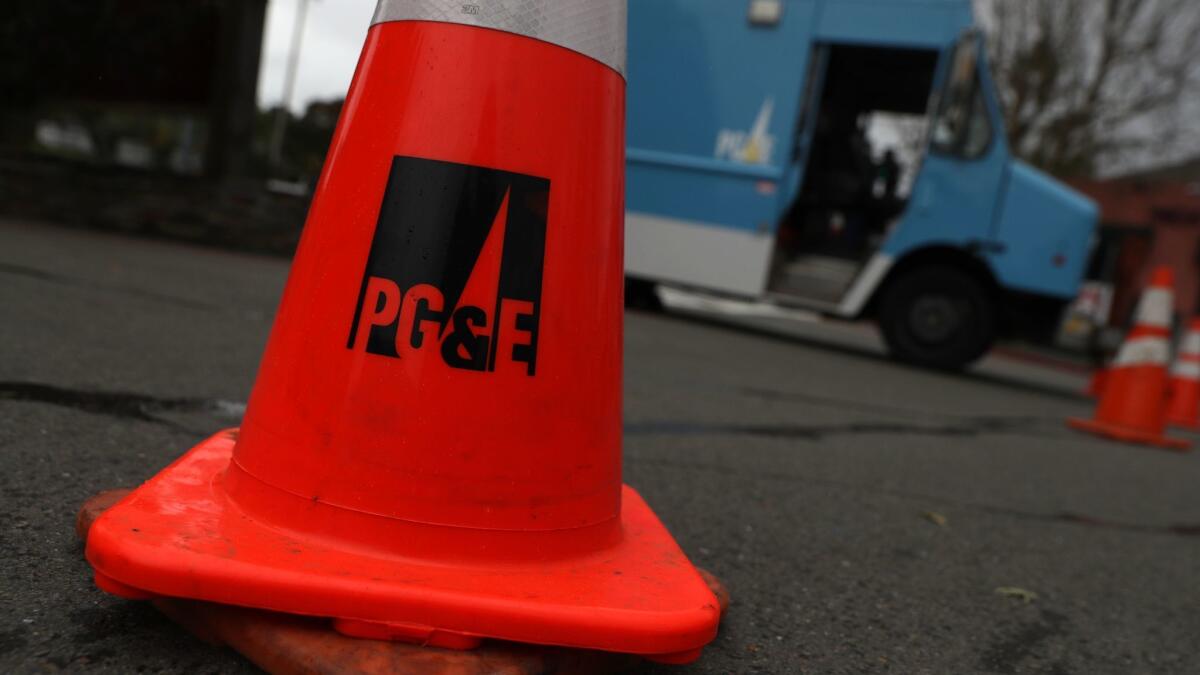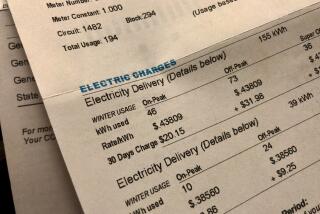PG&E takes a big step toward emerging from bankrupty as regulators OK the utility’s overhaul

California regulators approved PG&E Corp.’s $58-billion reorganization plan, bringing the power giant another step closer to exiting the biggest utility bankruptcy in U.S. history.
The state’s Public Utilities Commission voted unanimously in favor of PG&E’s proposal after the company agreed to revamp its board and governance structure, submit to greater regulatory oversight and create local operating units to ensure a greater focus on safety.
The changes, pushed by Gov. Gavin Newsom, are intended to dramatically overhaul California’s largest utility and prevent the type of recklessness that dragged it into bankruptcy.
PG&E filed for Chapter 11 bankruptcy protection last year after its equipment was blamed for some of the worst blazes in state history, including the Camp fire, which destroyed the town of Paradise and killed 85 people. This month, state regulators fined the company $1.9 billion in connection with the blazes, which destroyed thousands of homes and caused an estimated $30 billion in damage.
The company’s shares rose 2.1% after the close of regular trading on Wall Street.
As part of its bankruptcy proceeding, PG&E has agreed to settle claims totaling more than $25 billion from fire victims, insurers and local government agencies.
PG&E now only needs approval from the judge overseeing its bankruptcy in order to meet a state deadline of June 30 to qualify for a California fund to help utilities pay for future wildfire claims. Nearly all creditors voted in favor of PG&E’s proposal, including wildfire victims. Court hearings on the plan began Wednesday.
The commission approved PG&E‚Äôs proposal despite opposition from more than 200 local elected officials led by San Jose Mayor Sam Liccardo. The coalition, which had proposed to turn PG&E into a customer-owned cooperative, said in a letter to regulators that the utility‚Äôs plan would have it emerge as a ‚Äújunk bond‚ÄĚ company with a debt load of nearly $40 billion.
PG&E pushed back against that assertion, saying its plan will result in the issuance of investment grade bonds resulting in about $1 billion in interest costs savings.
There’s no guarantee a government entity would do a better job than Pacific Gas & Electric.
During the hearing Thursday, commissioners listened to more than two hours of public comment, with many speakers calling for a rejection of PG&E’s reorganization plan while advocating for a public takeover of the utility.
As a condition for regulatory approval, PG&E agreed to a six-step enforcement process that could ultimately lead to the state revoking its license to sell electricity if it gets in trouble again.
The commission also will require an independent safety monitor to watch the utility after the term of a federal court monitor expires.
PG&E said this month that only three of its current 14 board members will remain after it exits bankruptcy. Chief Executive Bill Johnson will also retire June 30.
Earlier Thursday in a separate proceeding, a federal judge ripped into PG&E for its resistance to his demands that the California utility adopt stricter wildfire safety measures.
‚ÄúIf ever there was a corporation that deserved to go to prison, it is PG&E for the people it killed in California,‚ÄĚ U.S. District Judge William Alsup said during a virtual hearing. ‚ÄúPG&E is a recalcitrant criminal, and I‚Äôm going to do everything within my power to protect the people of California from further crimes and further destruction by PG&E.‚ÄĚ
The San Francisco judge oversees the bankrupt company’s criminal probation stemming from a conviction for safety violations after a fatal gas-pipeline explosion in 2010. At the start of the hearing, he gave PG&E a chance to persuade him to modify or withdraw his recent order directing the company to hire an in-house team to spot-check the work of contractors who trim vegetation at risk of causing wildfires, and to take other rigorous safety measures.
PG&E argues the conditions imposed by Alsup violate the legal principle of federalism under which local governments maintain control over local affairs. The utility’s lawyer, Kevin Orsini, said the judge is required to defer to state regulators, including the Public Utilities Commission.
‚ÄúThe court is stepping into the role of the regulator to apply specific conditions about how PG&E maintains its system,‚ÄĚ Orsini said.
Alsup, who previously said the utility was violating its probation by falling behind on fire safety maintenance, also directed PG&E to maintain a rigorously detailed inventory, and inspection system, for every piece of equipment on every transmission tower and line across its vast grid in Northern California. Videos must be taken of every inspection, Alsup said. Finally, the utility must require all contractors to be insured to cover any wildfire losses that can be traced to inspection oversights.
The judge has recommended adopting harsher penalties for PG&E if it fails to maintain proper vegetation clearance. He’s also proposed tying executive bonuses to safety management, and continuing mandatory power shutoffs on windy days when there’s high fire danger. The company’s probation is set to expire in 2022.
Thursday‚Äôs hearing followed what‚Äôs become a familiar tug-of-war, with PG&E‚Äôs lawyer tactfully picking apart the judge‚Äôs demands as unrealistic. Alsup, in turn, said he‚Äôd been ‚Äúflimflammed‚ÄĚ by the utility‚Äôs attorneys, and derided as a ‚Äúcourtroom prop‚ÄĚ PG&E‚Äôs power line inspections, which he said are ‚Äúdesigned to conceal what really happened and what was really tested.‚ÄĚ
Alsup also heard from lawyers from the utilities commission, the U.S. Justice Department and, in a first, an attorney representing PG&E customers who argued the company is secretly influencing the PUC and stalling the court until its probation expires in a year and a half.
With California’s wildfire season fast approaching, Alsup ordered lawyers for the parties to file briefs on how PG&E’s vegetation management and power-line inspections can be meaningfully improved.
Clearly still grappling with just how far he can reach to prevent another utility-caused wildfire, Alsup took a parting shot at PG&E’s inability to keep up with California law requiring it to maintain safe distances between tree branches and its power lines.
‚ÄúYou‚Äôre very good at making excuses, you‚Äôre not good at complying with state law,‚ÄĚ he said.
More to Read
Inside the business of entertainment
The Wide Shot brings you news, analysis and insights on everything from streaming wars to production ‚ÄĒ and what it all means for the future.
You may occasionally receive promotional content from the Los Angeles Times.










